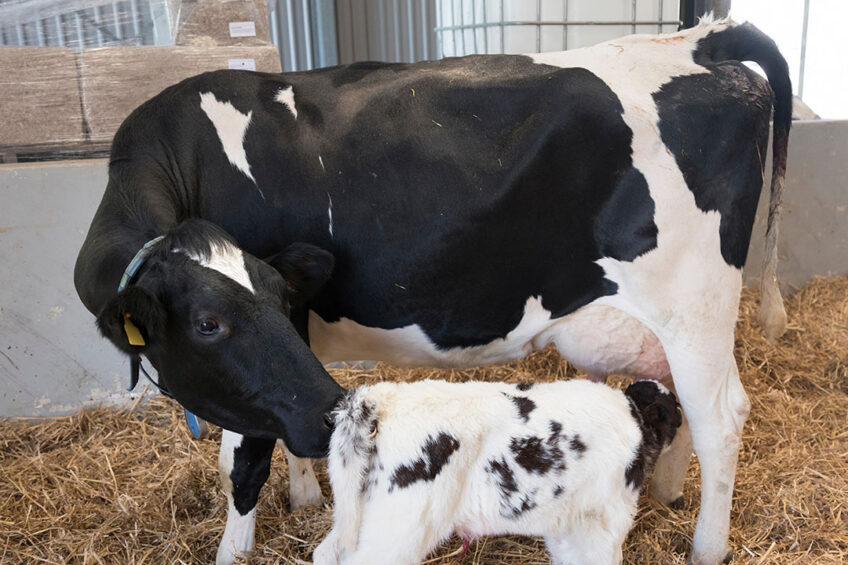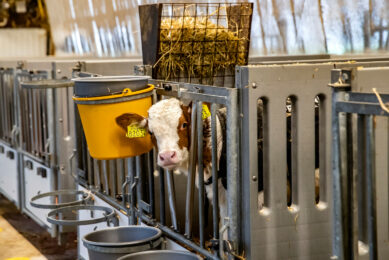Facilitating metabolic adaptation in cows

Negative energy balance (NEB), occurring around parturition, is the most common metabolic disorder in dairy cows.
Prior to calving, the cow has a low dry matter/low energy diet to cover maintenance needs and foetus development. However, immediately after calving, energy demands increase at a faster rate than energy intake, leading to NEB, a condition that can result in subclinical ketosis. To meet increasing energy demands, and to facilitate metabolic adaptation after calving, nutritional strategies are focused on high energy diets, using high quality forages to maximise dry matter intake. It is very common to supplement postpartum cows with additives, providing additional energy in the form of propylene glycol, protected fat, and calcium propionate to meet increasing energy demands. The main focus, as nutritionists, has always been on delivering more energy to help the cow cope with increasing milk production and to prevent a loss of body condition.
Innate immune system
An important, but commonly ignored, factor is that the innate immune system contributes to NEB after calving. Several researchers have published data showing that the immune system is often altered dramatically during the transition period, leading to substantial immune depression. At the same time, increased levels of circulating biomarkers of systemic inflammation have been observed. Inflammation is an immune response and is beneficial in recruiting innate immune cells for the inhibition of bacterial growth, but they come at a high energy cost to the animal. Importantly, inflammation can occur in the absence of a true pathogen challenge and can also occur without the traditional signs of focal pain, swelling, and redness. When inflammation blood markers are elevated, in the absence of clinical signs, this is often referred to as subacute inflammation. The triggers of systemic inflammation around calving are not entirely understood but are associated with parturition and the beginning of labour, placenta release, possible digestive disorders, leaky gut syndrome, and other high stress conditions.
Causes of NEB and subclinical ketosis
Subacute systemic inflammation comes at a high cost to the cow. The immune system is highly energy demanding and published data shows that cows with systemic inflammation require on average 1 kg of glucose more, during a 12-hour period, than cows without inflammation. The fact that the immune system is using primary glucose as an energy source, which is also needed by the mammary gland for milk production, leads to continuous immune depression and the prolongation of subacute systemic inflammation. An activated immune system around calving might be one of the primary triggers of NEB and subclinical ketosis. Research data demonstrates that reducing systemic inflammation immediately after calving may help promote faster metabolic adaptation and higher milk production.
A dairy cow’s immune system is often altered dramatically during the transition period. Immune changes often provoke systemic inflammation without any sign of infection. Inflammation is considered to be a major contributor to NEB, loss in milk production, and reproductive failure, due to high energy demands by the immune system to sustain the inflammation. It is generally accepted that subclinical ketosis leads to a reduction in dry matter intake of 20%, with a consequent reduction in milk production of about 2 kg. Calculations by the University of Toulouse and INRA show an economic loss of about € 210 per calving cow in cases of subclinical ketosis. Recently, however, it was proven that postpartum systemic inflammation can be addressed by the provision of proper nutrition and the inclusion of certain probiotics in the diet.
Figure 1 – Evolution of haptoglobin (g/L) content in blood over transition period.

Mitigating inflammatory markers
The probiotic yeast Actisaf Sc 47, from Phileo by Lesaffre, is well known for its effect on preventing acidosis and for improving fibre digestion in lactating dairy cows. Latest studies show that Actisaf Sc 47 supplementation, given from -21 to +21 days from calving (DFC), is able to mitigate inflammatory markers after calving, and significantly reduce blood haptoglobin (Figure 1) and BHBA (Figure 2) levels. Beta-hydroxybutyrate (BHB) is an important indicator of ketosis with values exceeding 1.2 mmol/litre blood being internationally recognised as suggesting subclinical ketosis. A study from 2018, measured the effect of the probiotic yeast in transition cows when supplemented from -21 to +21 DFC. A significant reduction of BHB concentration in the blood was recorded 28 days after calving, reducing the risk for ketosis. Daily feed intake was also higher at 15.6 kg dry matter in probiotic yeast group, throughout the trial period, versus 14.6 kg dry matter for control group cows. Milk production was consequently higher for supplemented group at 35.8 kg/d compared to the control group’s 33.8 kg/d.
Figure 2 – Blood BHB (mmol/L) content at 28 DFC.

Reducing the risk of milk fever
Cows supplemented with the yeast probiotic during transition also had higher dry matter intake, higher milk production, and lost significantly less body condition. The increase in milk production could be explained by better rumen health, boosting energy supplies to lactating cows. Better rumen health could also explain significant improvements in the absorption and bioavailability of magnesium from 1-28 DFC. This safeguards animal health by decreasing the risk of paresis (milk fever). Study evidence of significantly lower concentrations of blood haptoglobin and BHB reflects the reduction of both lipomobilisation processes and hepatic ketogenesis, suggesting an improvement in energy balance, reduced systemic inflammation, and a lowering of the risk of subclinical ketosis.
The yeast probiotic supplementation during transition reduced haptoglobin and BHB levels in the blood. This helped ensure a smoother transition, lowering systemic inflammation and the risk of subclinical ketosis. Actisaf Sc 47 supplementation is proven to improve energy status and metabolism, hence increasing the supply of energy for milk production. Our depth of understanding of probiotic strains allows us to develop innovative nutritional solutions to mitigate the negative effects of postpartum inflammation and NEB in high producing dairy cows.
References are available from the author on request
Authors: Valentin Nenov, PhD, Global Ruminant Manager, Phileo by Lesaffre & Mohamed Mammeri, PhD, Global Product Manager, Phileo by Lesaffre.
Join 13,000+ subscribers
Subscribe to our newsletter to stay updated about all the need-to-know content in the dairy sector, two times a week.







